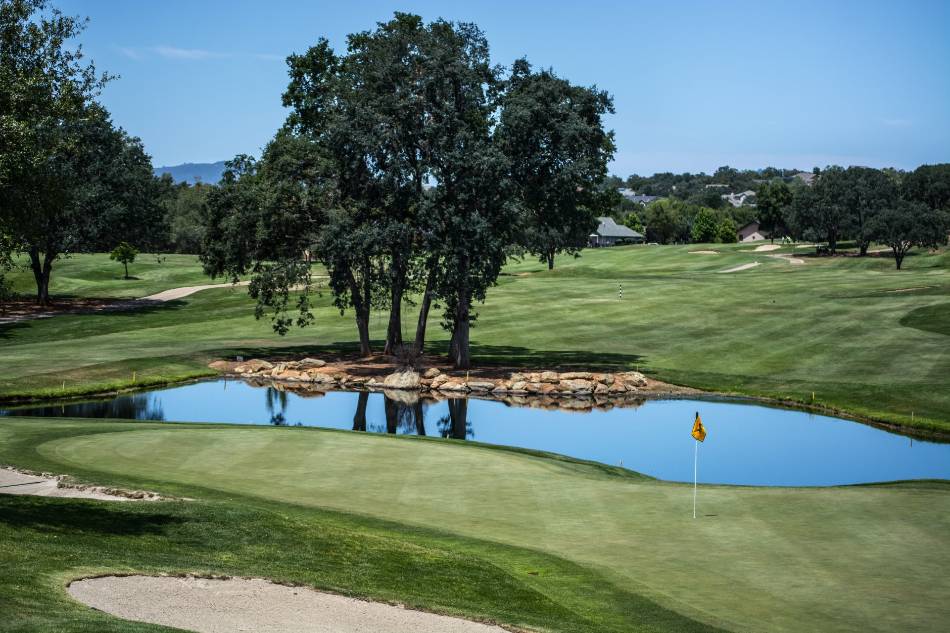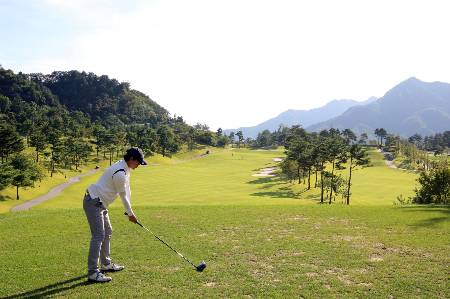
If you’re new to the game of golf, there’s a lot of terminology that gets thrown around which can be confusing. Most of these terms are vital to playing the game itself, while others involve the use of good etiquette. Yelling ‘fore’ falls into the latter category.
So, why do golfers yell ‘fore’?
Golfers yell fore as a verbal warning to nearby golfers that an errant shot has been hit in their direction. While not mandatory, it falls within the principles of proper golf etiquette to warn other golfers that a ball is heading their way.
Accompanied by the direction that the ball is heading, the word ‘fore’ is vital to maintaining positive relations with those golfing nearby.
Though one of golf’s major etiquette rules is to not talk loudly in someone’s backswing or shout while on the golf course, a vast majority of the golfing public will let you slide in this instance if it means they can avoid being hit by the small projectile.
What Is the Origin of the Word Fore in Golf?
An Old English word dating back as far as the 13th century, ‘fore’ is simply the abbreviated form of the words ‘afore’ and ‘before’ and refers to something or someone in front.
Using this definition, it is easy to see how the term has been adopted in golf as a warning for those golfers in front of you that a golf ball is headed towards them.
Fore as a Military Term
Much speculation surrounds the term ‘fore’ in regard to its use in the military. An article from scottishgolfhistory.org concludes the term is an abbreviation of the phrase ‘Beware Before’ and ‘fore’ is subsequently “derived from an artillery term warning gunners to stand clear”.
Still, the word’s connection to the game of golf is stronger when analyzing the term ‘fore-caddie’.
Forecaddie Meaning
The use of the term ‘fore’ in golf dates as far back as 1878 with its inclusion in the Oxford English dictionary, around the time golf was establishing its foothold in Scottish and English cultures.
Golf balls in the mid-1800s were very expensive to make and became valuable commodities to golfers of the time.
To reduce the number of golf balls lost during play, golfers would employ a ‘forecaddie’ to stand near the landing area of the shot to better locate the ball.
Shouting at the forecaddie to warn them of the incoming ball became the norm and over time, the ‘fore’ became the shortened dominant term used by golfers to signify that the ball was approaching the landing area.
Forecaddies are still used today by many golf resorts and private country clubs. While not free, the forecaddie’s service is paramount for golfers playing tough or unfamiliar courses as the number of lost golf balls increases in direct correlation to the difficulty of the golf course.
Professional golf tournaments enlist volunteers to serve as ‘spotters’ and stand guard near landing areas around the golf course to help locate errant golf shots.
It is common practice for spotters to place a colored irrigation flag near the golf ball to mark its location for the golfer.
Additionally, volunteers are also located behind the tee box with brightly colored paddles that are used to signal the direction the ball is headed to spotters located near the landing areas.
Is Yelling Fore the Only Thing I Should Do?

The answer here is no. First off, you should yell fore as soon as practicable to give enough time for the group in the line of fire to seek cover. Secondly, while shouting ‘fore’ is a great start, there are other things golfers should do to assist the group in front of you.
- Accompany the ‘fore’ with the direction the ball is hit, for example, ‘Fore right!’ or ‘Fore left!’ This tells people not in the path of the golf ball they are safe while providing clarity on the direction of the golf ball for those that are. Many pro golfers also point in the direction of their ball when yelling fore.
- Point your arm or the golf club up into the air, favoring the direction the golf ball is headed. If the ball is going right, use your right arm and if the ball is going left, well, use your left arm as the signal. As words shouted over distances of 200-300 yards can oftentimes be difficult to understand, the visual cue supplied by the raised appendage provides additional clarity as to the direction of the wayward shot.
- Open up your vocal cords and shout it like you mean it. A golf ball to the head does not feel good and the guilt felt at not yelling loud enough is not worth it when you could have just shouted a little louder.
What Happens When a Golfer Yells ‘Fore!’?
If you hear ‘Fore Right’ and it didn’t come from your mouth AND you’re standing on the right side of the hole, chances are there is a golf ball headed your way. Here are some tips for what you should do should such an occasion occur the next time you visit your local golf course:
- Don’t look up! The last thing you want is a golf ball to the face so save the trip to the emergency room and keep your eyes down.
- Duck and cover. Duck your head down and use your hands and arms to cover and protect your face, head and neck.
- Seek shelter. If you are near a tree, find refuge under its limbs and leaves as the obstacles will slow the downward trajectory of the ball. This way, even if you are hit by the ball, it won’t hurt as bad.
- Keep your cool. If a ball lands near you or actually hits you AND you heard the warning cry, mind your temper and understand that all golfers will hit bad shots. The intent to hit other golfers with a ball is very rare. A simple wave to say thanks for the warning is a great way to reciprocate the verbal warning from your fellow golfers. Chances are the golfer that yelled ‘fore’ feels terrible not only about almost hitting you but also because it was not a good shot.
How Often Do Golfers Yell Fore?

The frequency to which the word ‘fore’ is used is difficult to determine. However, it should be used every time you or any other golfer hits an errant shot near another person, even if the person is in the same group.
‘Fore!’ is used less often when golfers allow groups in front of them ample time to clear the landing area before any ball is hit.
One thing it’s never okay to do is hit a ball at or into the group in front of you because they are playing too slow, even if you intend to give them a warning by yelling ‘Fore!’ Additionally, you do not need to yell fore if no one is around.
Forecaddie vs Caddie
As discussed before, a forecaddie is someone who stands downrange from the golfer to locate golf balls hit during the play. A forecaddie’s job is fairly easy but does require some course knowledge.
A good forecaddie will know precisely where to stand to find errant golf shots, offer advice and yardages to players during play and clean clubs and golf balls when needed. One forecaddie will typically service an entire group or foursome of golfers.
Conversely, a caddie is a full-fledged golf assistant and will serve only one or two golfers at a time.
A caddie is your guide for the day and their primary job is to carry their player’s clubs. Caddies will also offer advice on every shot; from judging wind and elevation to calculating yardages and distances as well as offering suggestions on which club to use and how to read putts on a green.
The caddie’s sole goal is to ensure their player plays their best and has a great time on the golf course.
An overwhelming majority of professional golfers use caddies during tournament play. Rare is the site of a professional golfer carrying their own clubs.
Here, the caddie is a full-time employee of the professional golfer and their relationship is a very personal one. The caddie serves as the player’s coach, mentor, motivator, and advisor, and communication between the two is paramount to success.
One miscalculation on a caddie’s part can do a world of hurt to their player’s score and standing in a tournament.
Caddies typically wear a colored ‘bib’ that signifies their role and has pockets to store scorecards, pencils, rangefinders, ball markers, and tees. Caddies will also carry a wet towel to ensure their player’s golf clubs and balls are kept clean.
Every golfer should play a round of golf with a caddie at least once in their life, as it’s an unforgettable experience.
